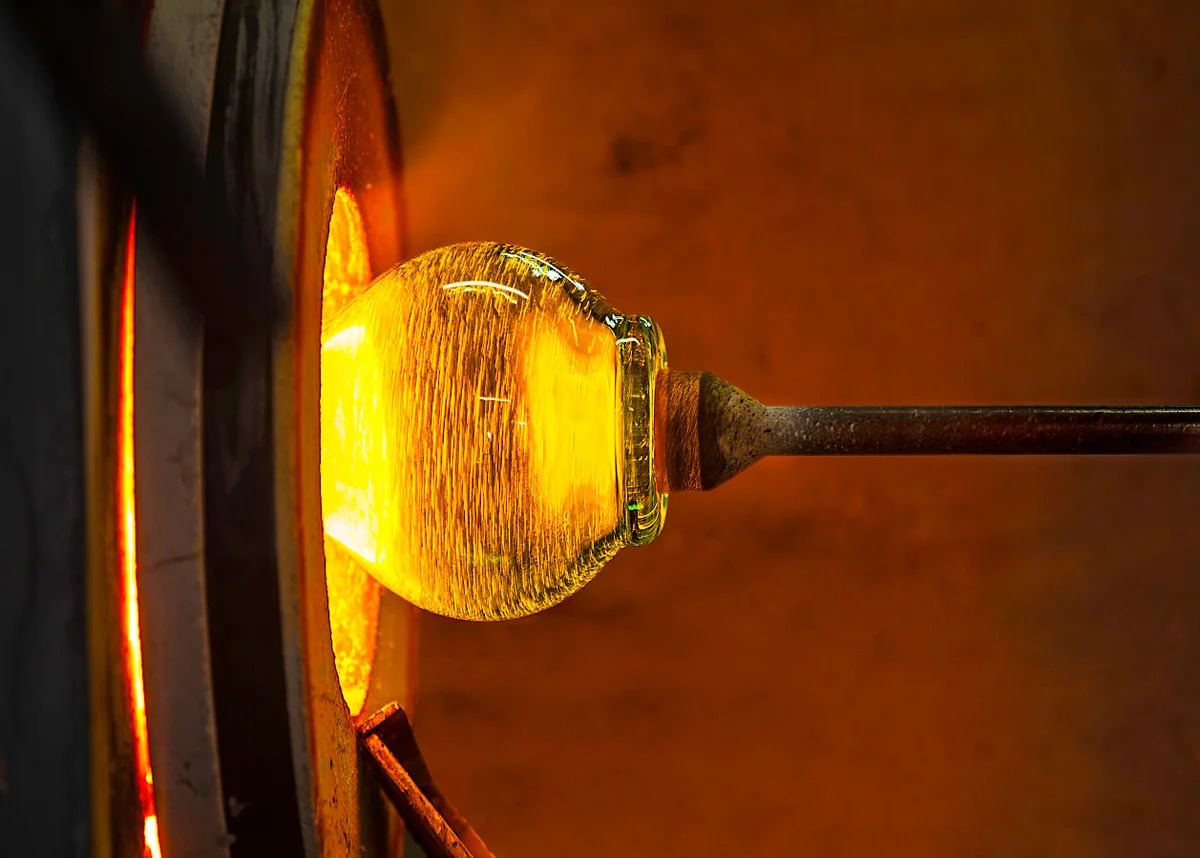Home>Furniture & Design>Interior Design Trends>What State Of Matter Is Glass


Interior Design Trends
What State Of Matter Is Glass
Published: February 5, 2024
Discover the latest interior design trends and learn about the unique state of matter that glass represents. Explore the intersection of science and style with our insightful guide.
(Many of the links in this article redirect to a specific reviewed product. Your purchase of these products through affiliate links helps to generate commission for Storables.com, at no extra cost. Learn more)
Introduction
Glass is a material that has been an integral part of human civilization for centuries. Its versatility and unique properties have made it a staple in various industries, from construction and architecture to interior design and art. The allure of glass lies in its transparency, allowing light to pass through and creating a sense of openness and brightness in any space. Whether it's the sleek façade of a modern skyscraper, the delicate curves of a hand-blown vase, or the practicality of a kitchen window, glass has the ability to both enhance and define the aesthetic of a space.
Throughout history, glass has been revered for its ability to transform raw materials into objects of beauty and utility. From the ancient art of glassblowing to the modern innovations in glass technology, this material has continually evolved to meet the demands of contemporary design and architecture. Its adaptability and malleability have allowed designers and architects to push the boundaries of creativity, resulting in breathtaking structures and functional art pieces that captivate the imagination.
In this article, we will delve into the nature of glass, exploring its defining characteristics and shedding light on its enigmatic state of matter. By understanding the essence of glass, we can gain a deeper appreciation for its role in shaping the world around us and its enduring influence on interior design trends. Let's embark on a journey to unravel the mysteries of this remarkable material and uncover the secrets of its state of matter.
Key Takeaways:
- Glass is an amorphous solid, blurring the line between solid and liquid states. Its unique properties make it a versatile and enduring material in architecture and design, inspiring creativity and innovation.
- The transparency, durability, and thermal insulating properties of glass make it a timeless medium for creative expression and functional design solutions. Its enigmatic state of matter invites exploration and imagination in interior design trends.
Read more: What Is The State Wildflower
Definition of Glass
Glass is a non-crystalline, amorphous solid material that is often transparent and has widespread applications in various industries. It is primarily composed of silica, soda ash, and limestone, along with other additives to modify its properties. The manufacturing process involves heating the raw materials to a high temperature until they melt and then cooling them rapidly to prevent the formation of a crystalline structure, resulting in the characteristic non-crystalline nature of glass.
One of the defining features of glass is its transparency, allowing light to pass through and creating a sense of openness and luminosity. This unique property has made glass a popular choice for windows, skylights, and architectural facades, as it can effectively illuminate interior spaces and connect them with the surrounding environment. Additionally, the transparency of glass enables it to showcase the beauty of objects placed behind or within it, making it an ideal material for display cases, art installations, and decorative elements in interior design.
In addition to its transparency, glass exhibits exceptional hardness and resistance to chemical corrosion, making it a durable and long-lasting material. Its smooth surface and impermeability to liquids make it suitable for applications such as kitchen countertops, tabletops, and bathroom fixtures, where hygiene and ease of maintenance are essential. Furthermore, the versatility of glass allows it to be shaped and molded into various forms, ranging from delicate, handcrafted art pieces to large-scale architectural components, showcasing its adaptability and aesthetic appeal.
Moreover, glass possesses thermal insulating properties, contributing to energy efficiency in buildings by reducing heat transfer and minimizing the need for artificial lighting. This makes it an environmentally sustainable choice for architectural design, aligning with the growing emphasis on green building practices and sustainable materials. The combination of these characteristics positions glass as a multifaceted material that transcends traditional boundaries, offering endless possibilities for creative expression and functional design solutions.
In essence, the definition of glass encompasses its composition, properties, and diverse applications, reflecting its significance as a fundamental element in the realms of architecture, interior design, and artistic expression. Its ability to embody transparency, durability, and aesthetic appeal makes it a timeless medium that continues to inspire innovation and elevate the visual and tactile experiences within the built environment.
Characteristics of Glass
Glass possesses a myriad of characteristics that contribute to its widespread utility and enduring allure. Its defining properties encompass transparency, hardness, versatility, and thermal insulating capabilities, making it a versatile material with diverse applications in architecture, interior design, and artistic expression.
Transparency is one of the most prominent characteristics of glass, allowing light to pass through and creating a sense of openness and luminosity in interior spaces. This unique property enables glass to serve as a conduit for natural light, illuminating rooms and connecting them with the external environment. Whether in the form of expansive windows, sleek partitions, or elegant skylights, glass infuses spaces with a captivating radiance, enhancing the visual appeal and ambiance of any setting.
In addition to its transparency, glass exhibits exceptional hardness and resistance to chemical corrosion, making it a durable and long-lasting material. Its smooth surface and impermeability to liquids make it suitable for a wide range of applications, including kitchen countertops, tabletops, and bathroom fixtures. The resilience of glass ensures that it can withstand daily wear and tear while maintaining its pristine appearance, adding a touch of sophistication and functionality to interior spaces.
Furthermore, the versatility of glass allows it to be shaped and molded into various forms, ranging from delicate, handcrafted art pieces to large-scale architectural components. Its adaptability as a material for sculptural installations, decorative accents, and structural elements underscores its capacity to transcend conventional design boundaries, offering endless possibilities for creative expression and aesthetic innovation.
Moreover, glass possesses thermal insulating properties, contributing to energy efficiency in buildings by reducing heat transfer and minimizing the need for artificial lighting. This sustainable attribute aligns with the growing emphasis on eco-friendly design practices and sustainable materials, positioning glass as a responsible choice for architectural applications.
In essence, the characteristics of glass encompass its transparency, durability, versatility, and thermal insulating capabilities, reflecting its significance as a fundamental element in the realms of architecture, interior design, and artistic expression. Its ability to embody these diverse traits makes it a timeless medium that continues to inspire innovation and elevate the visual and tactile experiences within the built environment.
Glass is actually an amorphous solid, which means it doesn’t have a regular crystal structure like other solids. It’s made by cooling a molten material, like sand, so it doesn’t have a fixed melting point like a true liquid.
The State of Matter of Glass
Glass is a material that defies conventional classification within the three primary states of matter—solid, liquid, and gas. While it exhibits properties of a solid, such as rigidity and resistance to flow, it lacks the crystalline structure characteristic of most solids. This unique characteristic places glass in a distinct state of matter known as an amorphous solid.
Unlike crystalline solids, which have a highly ordered atomic structure, glass lacks a regular, repeating pattern at the atomic level. Instead, its molecular arrangement is random and disordered, akin to that of a liquid. This lack of long-range molecular order gives glass its amorphous nature, blurring the line between solid and liquid states.
The transition of glass from a liquid to a solid state during the cooling process is not as straightforward as the freezing of a crystalline substance. Instead, glass undergoes a gradual transition from a supercooled liquid to a rigid, non-crystalline solid as it cools below its glass transition temperature. This transition is characterized by a significant increase in viscosity, causing the material to become increasingly resistant to flow.
The amorphous nature of glass grants it unique mechanical and optical properties, distinguishing it from crystalline solids. Its lack of a defined melting point allows it to soften and deform over a broad temperature range, making it amenable to shaping and forming through processes such as blowing, casting, and molding. This malleability sets glass apart from conventional solids and contributes to its versatility in artistic, architectural, and industrial applications.
Furthermore, the non-crystalline structure of glass endows it with optical isotropy, meaning that its properties are uniform in all directions. This isotropic nature allows glass to transmit light without scattering, resulting in its characteristic transparency and clarity. The absence of grain boundaries and structural imperfections found in crystalline materials contributes to the pristine appearance and optical purity of glass, making it an ideal medium for lenses, windows, and decorative objects.
In essence, the state of matter of glass as an amorphous solid distinguishes it from traditional crystalline solids, endowing it with unique properties that have shaped its role in architecture, design, and technology. Its enigmatic nature blurs the boundaries between solid and liquid states, offering a captivating canvas for creativity and innovation in the hands of designers, artists, and engineers.
Conclusion
In conclusion, the enigmatic state of matter of glass as an amorphous solid underscores its exceptional versatility and enduring relevance in the realms of architecture, interior design, and artistic expression. The unique combination of transparency, durability, and thermal insulating properties positions glass as a timeless medium that transcends traditional boundaries, offering endless possibilities for creative innovation and functional design solutions.
The amorphous nature of glass, characterized by its lack of long-range molecular order, distinguishes it from conventional crystalline solids, granting it a distinct set of mechanical and optical properties. This inherent flexibility and isotropic nature enable glass to transmit light without scattering, resulting in its characteristic transparency and optical purity. These qualities have made glass an indispensable element in architectural facades, interior partitions, and decorative elements, infusing spaces with a captivating radiance and visual allure.
Furthermore, the durability and resistance to corrosion exhibited by glass make it a practical and enduring material for a wide range of applications, from kitchen countertops and bathroom fixtures to structural components in modern buildings. Its ability to withstand daily wear and tear while maintaining its pristine appearance underscores its role as a symbol of sophistication and functionality in interior design.
Moreover, the thermal insulating properties of glass contribute to energy efficiency in buildings, aligning with the growing emphasis on sustainable design practices and eco-friendly materials. By reducing heat transfer and minimizing the need for artificial lighting, glass promotes a harmonious balance between environmental responsibility and aesthetic appeal, making it a preferred choice for contemporary architectural and interior design projects.
In essence, the state of matter of glass encapsulates its intrinsic allure and enduring relevance, reflecting its ability to inspire creativity, innovation, and sensory experiences within the built environment. As we continue to push the boundaries of design and technology, glass remains a steadfast companion, offering a canvas for artistic expression and a conduit for natural light, shaping the way we perceive and interact with the spaces around us. Its enigmatic state of matter serves as a testament to the boundless potential of this remarkable material, inviting us to explore new frontiers of design and imagination in the ever-evolving landscape of interior design trends.
Frequently Asked Questions about What State Of Matter Is Glass
Was this page helpful?
At Storables.com, we guarantee accurate and reliable information. Our content, validated by Expert Board Contributors, is crafted following stringent Editorial Policies. We're committed to providing you with well-researched, expert-backed insights for all your informational needs.
















0 thoughts on “What State Of Matter Is Glass”